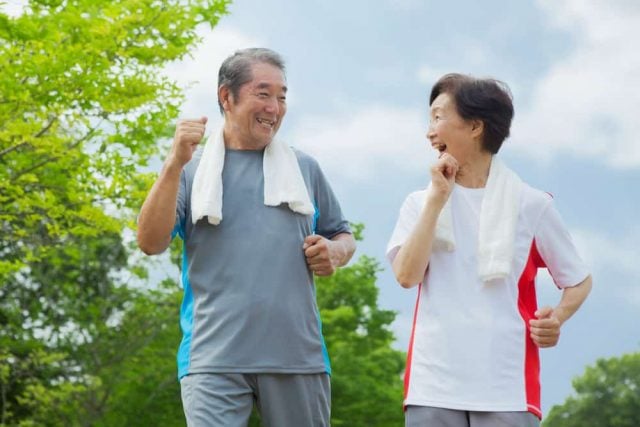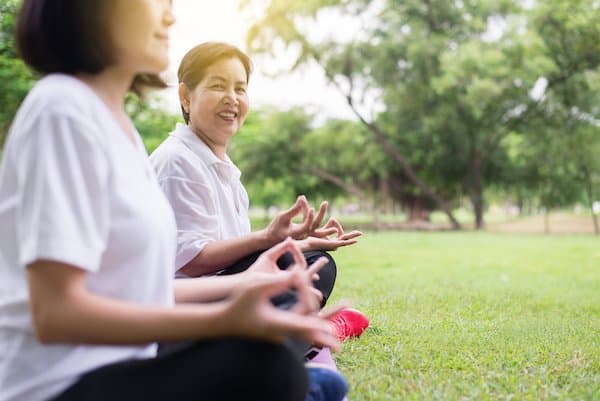Come on, recognize the benefits and types of exercise for the elderly
Many elderly people spend most of their time sitting or lying down. Even though it seems trivial, it turns out that this sedentary lifestyle (lazy to move) can increase the risk of various degenerative diseases in the elderly. So, in order for the elderly to stay active, they need to exercise. In fact, what are the benefits of exercise for the elderly? Then, what types of exercise are safe for them?
Benefits of exercise for the elderly
Routine exercise is part of implementing a healthy lifestyle for all ages, including the elderly. The Centers for Disease Control and Prevention (CDC) states that the elderly should exercise at least 150 minutes a week or 30 minutes per day 5 days a week.
There are many reasons why exercise is so important for older people, including:
1. Reducing the risk of degenerative diseases

The older a person gets, the risk of various health problems will increase. This disease, which is related to the aging of a person, is a degenerative disease.
There are many types of degenerative diseases, but the most common are heart disease, diabetes, hypertension, osteoporosis, and obesity. Well, one way to prevent this disease is to be diligent in exercising. The following is an explanation of how exercise can reduce degenerative diseases in the elderly.
Maintain heart health
First, exercise is healthy for the heart. When exercising, the body’s cells need more oxygen to produce energy. In order for the body’s cells to get adequate oxygen intake, oxygen-rich blood will flow more smoothly to the body’s cells. This process indicates that exercise stimulates blood circulation to become smoother.
Smooth blood circulation and oxygen circulation involves the performance of the heart in pumping blood. This is what makes exercise very healthy for the heart health of the elderly.
In addition, exercise also helps lower blood pressure, high cholesterol and troglyceride levels. All of these benefits can reduce the risk of hypertension, heart disease, and stroke.
Control body weight and lower blood sugar
When you exercise, your body needs more energy. This activity allows the burning of excess fat in the body so that the body’s energy for exercise is still available. This reason makes the elderly need to undergo regular exercise to help lose weight or help control body weight to remain ideal.
To find out whether your body mass index is ideal or not, calculate it with this BMI Calculator or via the following link bit.ly/
Not only affects body weight, exercise can also help lower blood sugar levels in the body. The hormone insulin, which is a hormone that regulates blood sugar levels, can also work better if the elderly are diligent in exercising. Increased insulin sensitivity and stable blood sugar levels help the elderly prevent the development of diabetes.
Improve muscle and bone health
Young women and men who exercise regularly generally have maximum bone density and strength, compared to those who don’t. For most people, bone mass reaches its peak in 30 years. After that, you will start to lose bone mass. In young people, exercise can help prevent bone loss.
Not only that, exercise in the elderly is also beneficial for maintaining bone health. The reason is because exercise increases muscle strength, improves body balance and coordination, so that it can prevent the elderly from falling or breaking bones.
2. Maintain mental health

Mental disorders in the elderly often occur, one of which is depression. This is because in old age, the elderly tend to feel lonely and their health deteriorates, making them easily stressed and anxious. In order to maintain mental health in the elderly, exercise can be one way to achieve this.
Exercise can improve a bad mood, which can help reduce stress and anxiety. Exercising can be a fun time for the elderly with their family. This activity can also be a bridge for the elderly to socialize with those around them so that it helps reduce feelings of loneliness.
Not only psychologically, exercise also improves brain function, namely sharpens thinking skills. The reason is, when the elderly do exercise, the body will release protein and other chemicals that are beneficial to your brain.
3. Improve sleep quality and quality of life

Generally, the elderly do exercise in the morning. This allows the elderly to get morning sun which is good for the bones. Sun exposure improves the function of the body’s biological clock, namely the body’s clock in regulating waking and sleeping.
Indirectly, this can help the elderly to sleep better. Moreover, exercise also reduces stress and anxiety, so it makes the mind calmer and the elderly can sleep easier.
For the elderly with degenerative diseases, exercise can help them stay healthy and fit. They can control their weight, keep blood pressure and blood sugar stable, and get enough sleep.
Reported by the Medline Plus site, exercise also helps the elderly to quit smoking. This is because exercise can reduce the often annoying nicotine withdrawal symptoms. So, it can be concluded that exercise can help improve the quality of life for the elderly for the better.
A safe choice of exercise for the elderly

Despite the many benefits, not all types of exercise are safe for the elderly. Especially if the elderly have health problems, which are related to the heart, nerves, bones or joints. So, before you get ready to exercise, it’s a good idea to consult your doctor first about this plan.
The following are various exercise options that are safe for the elderly.
1. Aerobic exercise
Aerobic exercise can help the elderly to burn excess fat, lower blood pressure and bad cholesterol, and maintain flexibility and joint health, and can increase the body’s overall energy level.
Try to start by doing simple movements like squat or sit-ups. The process of building muscle takes time, but doing exercise is very beneficial for the elderly.
You can start by doing low-impact movements, such as squats (using a chair at home), tai chi, swimming, walking leisurely or brisk walking, cycling. If you do this regularly for at least 6 weeks, you will feel the impact on your health, such as feeling more fit and strong.
Do aerobic exercise at least 3 days a week to help avoid excessive fatigue and reduce the risk of injury. However, you need to make adequate preparations, for example the preparation of the elderly before swimming is very necessary.
2. Exercises strengthen muscles
A safe choice of exercise for the elderly is exercise to increase muscle strength. In young people, sports to increase muscle strength can be in the form of weight training. However, in the elderly, lifting weights is quite risky.
Elderly people can do some yoga, tai chi, or gymnastics. Do this exercise 2 times a week. Each workout, do two to one set of exercises. Each set, usually consists of 8 to 12 repetitions.
Apart from exercise, there are many daily activities that you can actually use as muscle strengthening exercises. For example, carrying groceries, digging in the ground when gardening, or lifting and moving objects at home.
3. Exercise balance
Elderly people fall very easily because their ability to maintain body balance begins to decline. Therefore, balance training can be the right choice of exercise for the elderly. You can do this exercise 3 days a week. Examples of balance exercises that can be options are yoga or tai chi.
In addition to these exercises, you can do simpler balance exercises at home. Try to follow these sample exercises and do 2-3 sets of repetitions, each of which consists of 8 reps.
Some of the balance exercises for the elderly include:
- Walk back and walk to the side. Make sure you are in a large, free room with furniture and floors that are not slippery.
- Stand on one leg alternately and hold for 8 seconds. You can bend your leg forward or back as comfortable as possible.
4. Flexibility exercises
This type of exercise is safe for the elderly. This exercise can increase the mobility of the elderly or expand the ability to move the body of the elderly. Examples of exercises to increase flexibility are yoga for the elderly, gymnastics for the elderly, dancing, and some stretching moves.
The easiest exercise option is stretching. You can follow some of the easy moves at home.
- Neck stretch. Sit in an upright position and stretch your neck down toward your chest. Then, point your head to the right and left, then turn it clockwise. Each movement hold the position for 15 seconds.
- Hip stretch. Position your body lying on your back and bend one knee. Then, bring your bent knee toward the other leg and hold it for 15 seconds. Do the same with the other leg.
What is the ideal duration of exercise for the elderly?

Although exercise is healthy for the elderly, it is also important to pay attention to how long the elderly do exercise. The reason is, excessive exercise can actually cause problems, such as injury, fatigue, or trigger the recurrence of certain disease symptoms.
The duration of exercise for the elderly is 150 minutes a week, or 30 minutes per day 5 times a week. The CDC says that people aged 65 years or older, healthy, and without limiting health problems, can follow exercise guidelines and regulate the duration.
- Elderly who do moderate intensity aerobic exercise, such as brisk walking, the duration is 30 minutes a day and do it 5 times a week. Complete with exercises to strengthen muscles 2 times a week. Make sure that the training movements prioritize the main muscles of the body, namely the leg muscles, back muscles, abdominal muscles, chest muscles, shoulder muscles, and arm muscles.
- If you do high-intensity aerobic exercise, such as jogging or running, the duration is 75 minutes (1 hour 15 minutes). Do this exercise once a week. Complete with exercises to strengthen the body muscles 2 times a week. Prioritize movements that strengthen the muscles of the legs, hips, stomach and arms).
- Seniors can also mix moderate and high intensity aerobic exercise, at least 2 days a week. Then, complete with exercises to strengthen the muscles of the body.
Making an exercise plan, especially for the elderly is not an easy task. Especially for the elderly with certain health problems and ensure that this activity is applied consistently to get its benefits. So, don’t hesitate to consult a doctor who treats their condition.
You may also need to consult with a nutritionist so that the nutritional needs of the elderly during exercise are still met properly. This is important to keep the elderly healthy and happy in carrying out their activities.